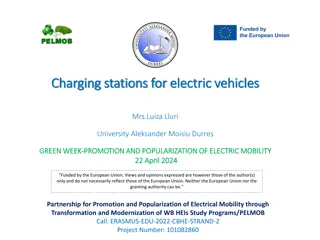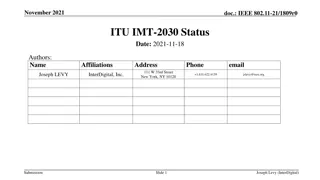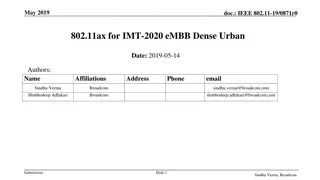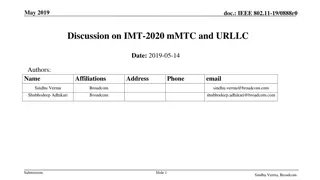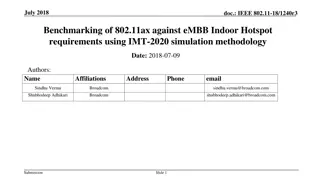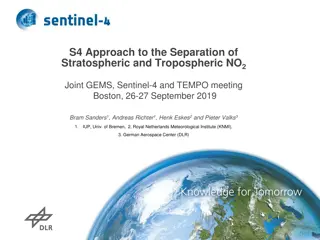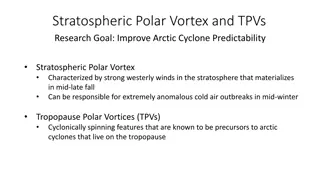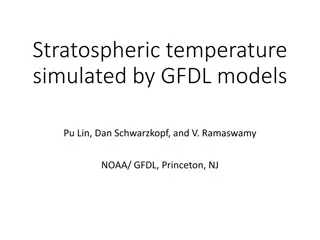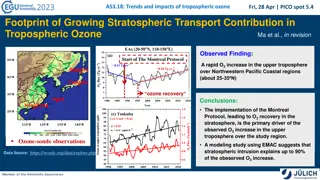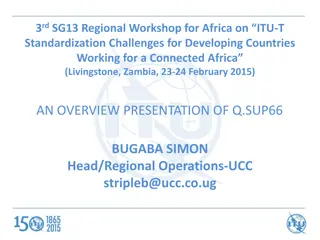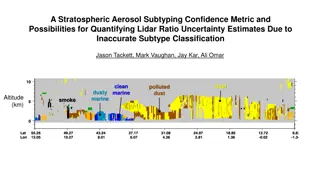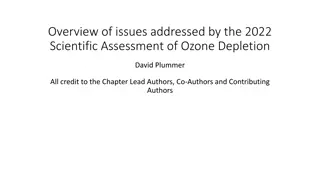IMT Connectivity by Stratospheric Base Stations (HIBS) Overview
The document presents information on High-Altitude Platform Stations (HIBS) as International Mobile Telecommunications base stations. It discusses the regulatory situation, support for IMT band plans, and the role of Agenda item 1.4 in WRC-23. Additionally, it outlines the work of ITU-R WP5D and upcoming meetings related to HIBS. The content highlights the potential for HIBS to enhance IMT connectivity through additional bands and compatibility studies.
Download Presentation

Please find below an Image/Link to download the presentation.
The content on the website is provided AS IS for your information and personal use only. It may not be sold, licensed, or shared on other websites without obtaining consent from the author. Download presentation by click this link. If you encounter any issues during the download, it is possible that the publisher has removed the file from their server.
E N D
Presentation Transcript
IMT Connectivity by Stratospheric Base Stations (HIBS) EACO WRC-23 Preparatory meeting 17th 19thAugust 2021 HIBS: high-altitude platform stations as International Mobile Telecommunications base stations 1
Disclaimer This presentation material is made based on information available at the time of writing. Plans, forecasts, strategies, and other forward-looking statements in this presentation are not historical facts, and include elements of risk and uncertainty. Actual results may therefore differ materially from these forward-looking statements due to changes in the business environment and other factors. 2
The regulatory situation today Existing ITU Radio Regulations (RR 5.388A) allow for the use of HIBS in parts of the 2 GHz range identified for IMT (Resolution 221). Adopted by 45 countries, RR 5.388B identifies technical conditions to enable the use of HIBS while providing protection to terrestrial IMT and other mobile and fixed services. Agenda item 1.4 for WRC-23 will consider the use of the bands identified for IMT below 2.7 GHz by HIBS (without negatively impacting ground based IMT services) ITU-R WP5D is responsible for the sharing and compatibility studies on WRC-23 agenda item 1.4
Support for IMT band plans Additional IMT bands to be used by HIBS under agenda item 1.4 (specifically 1710-1885 MHz) together with existing HIBS bands (1885-1980 MHz and 2110-2160 / 2170 MHz) will allow the use of two major band plans: 1710-1785 MHz / 1805-1880 MHz - ITU Region 1 band plan for the 1800 MHz band 1920-1980 MHz / 2110-2170 MHz ITU Region 1 band plan for the 2.1 GHz band Agenda item 1.4 would also pave the way for HIBS to use the full band plans for the 700 MHz, 800 MHz, 900 MHz and 2.6 GHz bands This will allow an MNO to use any of its licensed frequencies in a HIBS system
Agenda item 1.4 in ITU-R WP5D WP5D working on documents to assist with the sharing and compatibility studies: Preliminary Draft New (PDN) Report ITU-R M.[HIBS-CHARACTERISTICS] Completed developing HIBS parameters at June 2021 meeting Working Document towards sharing & compatibility studies Section A4.5 Sharing and compatibility studies with MSS in 2500-2535 MHz (s-E) and 2655-2690 MHz (E-s) bands: 1) MSS allocation applies only in ITU Region 3; 2) Sharing studies with MSS should not extend to ITU Region 1 (or Region 2) possible input contribution Next meeting of WP5D scheduled for 4-15 October 2021
Summary With access to IMT spectrum below 2.7 GHz, HIBS will be able to: Extend coverage of terrestrial IMT base stations to improve mobile broadband connectivity in unserved and underserved areas; existing base stations will not be replaced, hence no loss of revenue to regulator from licensing of fixed links; Support a wide range of safety, security, consumer and business applications without negatively impacting existing services in the IMT bands; Help accelerate the deployment of 5G; Make use of the channel plans for the 700 / 800 / 900 / 1800 / 2100/ 2600 MHz bands. Issues on WRC-23 AI 1.4 being discussed at ITU-R WP5D include Sharing studies with MSS in the 2500-2535 MHz (s-E) and 2655-2690 MHz (E-s) bands and whether they should extend beyond ITU Region 3
Request For the ITU-R studies to assess the compatibility of HIBS with terrestrial IMT and other services operating in the bands below 2.7 GHz: Identify any concerns of the EACO Member States in terms of protecting both ground based IMT systems as well as any other uses within the bands considered for HIBS and in adjacent bands; Indicate if any EACO Member State would provide any sharing and compatibility studies related to the issues of concern and/or Administration views about addressing concerns; Submit input contribution to next WP5D meeting indicating that sharing studies with MSS in the 2500-2535 MHz (s-E) and 2655-2690 MHz (E-s) bands should not extend beyond ITU Region 3




